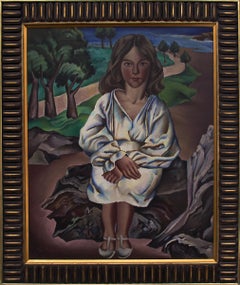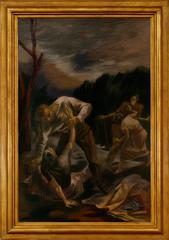Peppino Mangravite for sale on 1stDibs
Peppino Mangravite Born Italy, 1896
Died Connecticut, 1978
After studies at the Scuola Tecnica and the Belle Arti in Carrera, Italy, Peppino Mangravite left his native country for the United States.
Once in America, Mangravite continued his studies at the Cooper Union Art School and the Art Student’s League in New York. He later returned to instruct at both schools. He also taught at the Art Institute of Chicago, Columbia University, the Avon School in Connecticut, Sarah Lawrence College, Ethical Culture School in Connecticut and served as Director of Art Education at Fielding School in Washington, DC.
It was teaching that brought Mangravite west to Colorado during 1937 and 1938 when he taught at the Broadmoor Art Academy (forerunner to the Colorado Springs Fine Arts Center) in Colorado Springs. He returned to the Broadmoor Academy during the summers of 1946 and 1947 when he served as the Acting Director. He also instructed at the Fountain Valley School in Colorado Springs.
Mangravite contributed to several publications including Progressive Education, The Arts, and American Magazine of the Arts. He was member of the Board of Directors of the Artists Equity Association of New York City in the late 1940's and early 1950's.
Exhibited: Salons Of America, 1922-24; Sesqui-Centennial Expo Philadelphia, 1926 (Gold); Washington WCC; Society of Washington Artists, 1926-27; Society of Indianapolis Artists; Pennsylvania Academy of the Fine Arts, 1929-31, 1936-54, 1962; Corcoran Gallery Biennials, 1930-53 (10 times); Art Institute of Chicago, 1930-49 (prize, 1942); Whitney Museum of American Art; Toledo Museum of Art; Cincinnati Art Museum; Carnegie Institute; Nebraska Art Association; Venice Biennale, Italy,1938; World’s Fair New York, 1939; Golden Date Exposition, San Francisco, 1939 (purchase prize); Woodmere Art Galley, 1943; Architecture League, New York, 1955 (silver medal for mosaic design); 48 solo exhibits in New York City, Washington DC, Chicago, Colorado, California, Frank Rehn Gallery, New York City, 1970s.
Works Held: Corcoran Gallery of Art; Metropolitan Museum of Art; Whitney Museum of American Art; Phillips Memorial Gallery; Art Institute of Chicago; Pennsylvania Academy of Fine Arts; Toledo Museum of Art; Denver Art Museum; California Palace of the Legion of Honor; Cincinnati Art Museum; Encyclopedia Britannica Collection; Governor’s Mansion, Virgin Islands.
Murals Held: Federal Art Project of the Works Process Administration “History of Transportation” United States Post Office, Hempstead, New York, 1933; “Americas at Rest and Play” United States Post Office, Atlantic City, 1935;
©David Cook Galleries, LLC
Finding the Right Figurative-paintings for You
Figurative art, as opposed to abstract art, retains features from the observable world in its representational depictions of subject matter. Most commonly, figurative paintings reference and explore the human body, but they can also include landscapes, architecture, plants and animals — all portrayed with realism.
While the oldest figurative art dates back tens of thousands of years to cave wall paintings, figurative works made from observation became especially prominent in the early Renaissance. Artists like Michelangelo, Leonardo da Vinci and other Renaissance masters created naturalistic representations of their subjects.
Pablo Picasso is lauded for laying the foundation for modern figurative art in the 1920s. Although abstracted, this work held a strong connection to representing people and other subjects. Other famous figurative artists include Francis Bacon and Lucian Freud. Figurative art in the 20th century would span such diverse genres as Expressionism, Pop art and Surrealism.
Today, a number of figural artists — such as Sedrick Huckaby, Daisy Patton and Eileen Cooper — are making art that uses the human body as its subject.
Because figurative art represents subjects from the real world, natural colors are common in these paintings. A piece of figurative art can be an exciting starting point for setting a tone and creating a color palette in a room.
Browse an extensive collection of figurative paintings on 1stDibs.

